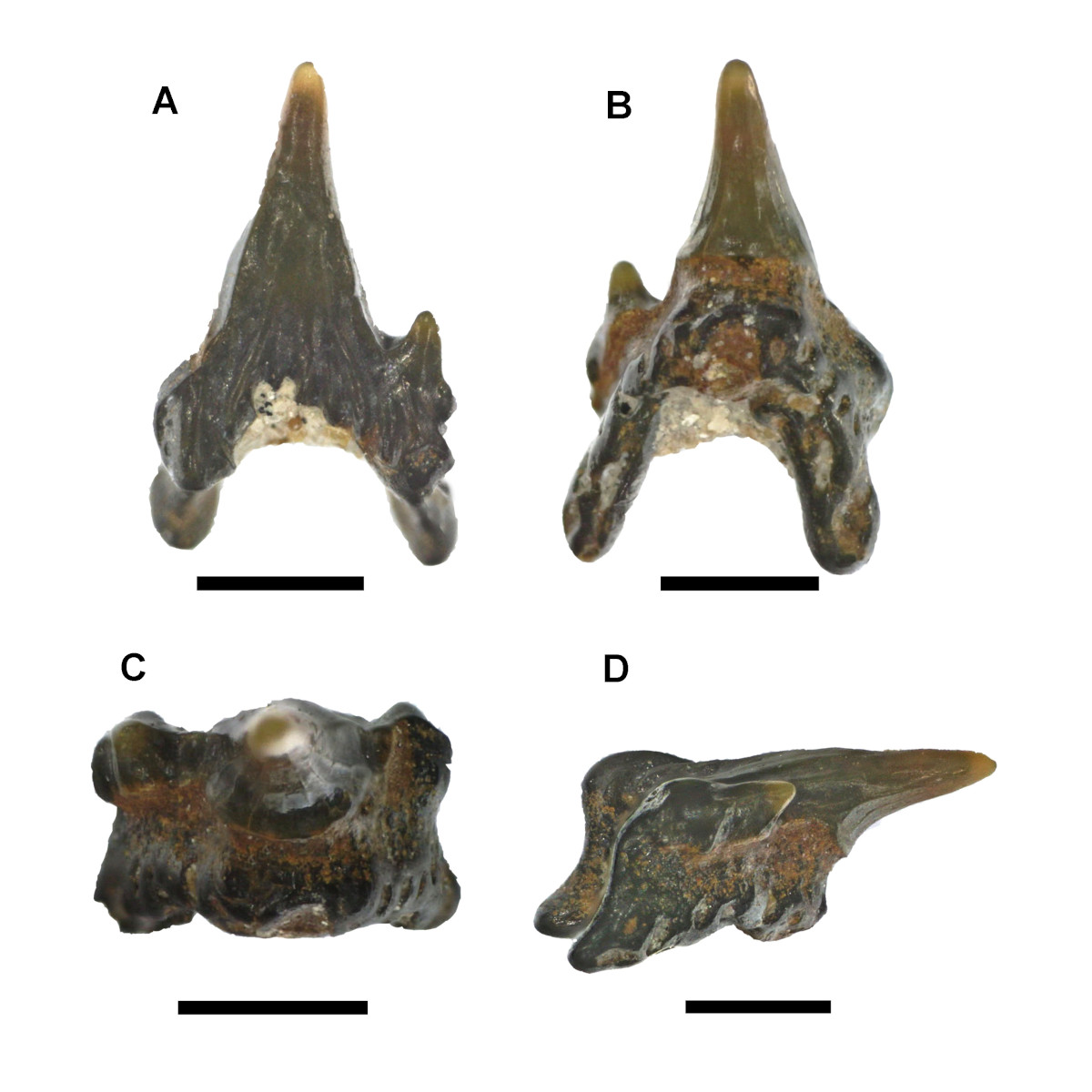Pteroscyllium downesi
Duffin & Batchelor, 2024
Classification: Elasmobranchii Carcharhiniformes Scyliorhinidae
Reference of the original description
New Carcharhiniform sharks from the marine Early Cretaceous of Southern England. Neues Jahrbuch für Geologie und Paläontologie, Abhandlungen, 310/2, 161–181
New Carcharhiniform sharks from the marine Early Cretaceous of Southern England. Neues Jahrbuch für Geologie und Paläontologie, Abhandlungen, 310/2, 161–181
Types
Pteroscyllium downesi
Pteroscyllium downesi
Description:
Citation: Pteroscyllium downesi Duffin & Batchelor, 2024: In: Database of fossil elasmobranch teeth www.shark-references.com, World Wide Web electronic publication, Version 12/2025
Please send your images of "Pteroscyllium downesi" to info@shark-references.com

Pteroscyllium downesi Duffin & Batchelor, 2024, holotype, NHMUK PV P 76886, Bed 16 of the Atherfield Clay Formation, Isle of Wight. A – labial view; B – lingual view; C – occlusal view; D – lateral view. Scale bar = 1 mm © Duffin & Batchelor, 2024

Pteroscyllium downesi Duffin & Batchelor, 2024, holotype, NHMUK PV P 76886, Bed 16 of the Atherfield Clay Formation, Isle of Wight. A – labial view; B – lingual view; C – occlusal view; D – lateral view. Scale bar = 1 mm © Duffin & Batchelor, 2024
Distribution Geographic
Type locality: Atherfield Point, Chale Bay, Isle of Wight. Bed 16 crops out at circa 50° 36′ 23.64″ N, 1° 20′ 57.98″ W; Bed 19 crops out at circa 50° 36′ 19.84″ N, 1° 20′ 49.41″ W. The beds crop out in a 100m section at approxiamtely NGR SZ462 787 [32662]
Type locality: Atherfield Point, Chale Bay, Isle of Wight. Bed 16 crops out at circa 50° 36′ 23.64″ N, 1° 20′ 57.98″ W; Bed 19 crops out at circa 50° 36′ 19.84″ N, 1° 20′ 49.41″ W. The beds crop out in a 100m section at approxiamtely NGR SZ462 787 [32662]
Distribution Stratigraphy
Type horizon: Upper Lobster Member, Atherfield Clay Formation (early Aptian, Early Cretaceous). [32662]
Type horizon: Upper Lobster Member, Atherfield Clay Formation (early Aptian, Early Cretaceous). [32662]
Description
Original diagnosis after Duffin & Batchelor (2024) [32662]: Teeth of scyliorhinoid organization showing some heterodonty and possessing the following combination of characters: anterior teeth possess a relatively high, slender and acuminate central cusp flanked by two pairs of lateral cusplets in which the most mesial and distal examples are rudimentary or incipient. The crown is heavily ornamented labially by a series of coarse longitudinal ridges descending from the cusp apices to the basolabial crown border. Ridge bifurcation is common and some ridge coalescence takes place. Two prominent lateral ridges show some deviation down the lateral heels of the crown toward their base. Lingual ornamentation is finer, but ridges extend for the full height of the cusps. Lateral cusplet axes are subparallel to the central cusp axis. Lateral teeth show similar ornamentation to that in anterior teeth but the central cusp is shorter, widerbased and more distally inclined. Posterior teeth have an even wider base to the central cusp, which is inclined distally even further, and relatively shorter, somewhat incurved lateral cusplets. The basolabial border of the crown is strongly arched in anterior and anterolateral teeth but more gently curved in posteriors. The root is holaulacorhize with mesial and distal lobes that extend for a short distance beyond the lateral heels of the crown and a relatively small lingual protuberance that is almost flush with the base of the central cusp.
Original diagnosis after Duffin & Batchelor (2024) [32662]: Teeth of scyliorhinoid organization showing some heterodonty and possessing the following combination of characters: anterior teeth possess a relatively high, slender and acuminate central cusp flanked by two pairs of lateral cusplets in which the most mesial and distal examples are rudimentary or incipient. The crown is heavily ornamented labially by a series of coarse longitudinal ridges descending from the cusp apices to the basolabial crown border. Ridge bifurcation is common and some ridge coalescence takes place. Two prominent lateral ridges show some deviation down the lateral heels of the crown toward their base. Lingual ornamentation is finer, but ridges extend for the full height of the cusps. Lateral cusplet axes are subparallel to the central cusp axis. Lateral teeth show similar ornamentation to that in anterior teeth but the central cusp is shorter, widerbased and more distally inclined. Posterior teeth have an even wider base to the central cusp, which is inclined distally even further, and relatively shorter, somewhat incurved lateral cusplets. The basolabial border of the crown is strongly arched in anterior and anterolateral teeth but more gently curved in posteriors. The root is holaulacorhize with mesial and distal lobes that extend for a short distance beyond the lateral heels of the crown and a relatively small lingual protuberance that is almost flush with the base of the central cusp.
Remarks
shark-references Species-ID=17166
shark-references Species-ID=17166
References

New Carcharhiniform sharks from the marine Early Cretaceous of Southern England. Neues Jahrbuch für Geologie und Paläontologie, Abhandlungen, 310/2, 161–181
DOI: 10.1127/njgpa/2023/1176

New Carcharhiniform sharks from the marine Early Cretaceous of Southern England. Neues Jahrbuch für Geologie und Paläontologie, Abhandlungen, 310/2, 161–181
DOI: 10.1127/njgpa/2023/1176

















